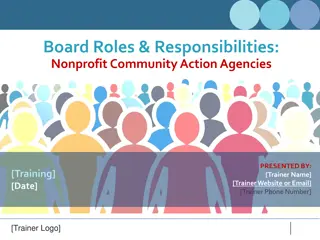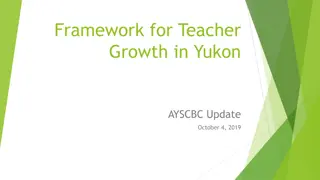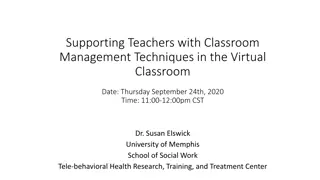Understanding Paraeducator Roles and Responsibilities in the Classroom
This material discusses the roles and responsibilities of paraeducators in educational settings, emphasizing their support for instruction, documentation/data collection, and collaborative work with partner teachers. It covers learning intentions, success criteria, defining the paraeducator role, and specific responsibilities in areas such as support, assessment, instruction, and behavior support. The content aims to clarify the distinctions between paraeducators and partner teachers while highlighting the importance of teamwork and supervision.
Download Presentation

Please find below an Image/Link to download the presentation.
The content on the website is provided AS IS for your information and personal use only. It may not be sold, licensed, or shared on other websites without obtaining consent from the author. Download presentation by click this link. If you encounter any issues during the download, it is possible that the publisher has removed the file from their server.
E N D
Presentation Transcript
Lifelines in the Classroom Presented by: Fort Bend Independent School District Special Education Department January 20, 2022 Adapted from Region 4 Education Service Center
Learning Intentions Understand the roles and responsibilities of a paraeducator. Understand how a paraeducator can support the instruction process. Gain knowledge and resources for documentation/data collection.
Success Criteria I will have a better understanding of the paraeducator s roles and responsibilities in the classroom. I will have a better understanding of how paraeducators support the instruction process. I will have a better understanding of the resources used for data collection.
Defining the Role of the Paraeducator Learning Objectives: Recognize that a paraeducator s actions are under the direction and supervision of the partner teacher. Discuss the distinctions between roles and responsibilities of paraeducators and partner teachers and how they will vary across settings.
While specific descriptions of responsibilities are left up to individual states and local education agencies, the following provides guidance for determining roles and responsibilities in the following areas: The Roles and The Roles and Responsibilities Responsibilities of of Paraeducators Paraeducators Setting/Organization Support Assessment Goals and Objectives Instruction Positive Behavior Supports
Teacher Paraprofessional Takes responsibility for instruction of new concepts, skills, and each new classroom activity. Revises instructional programs. Designs and adapts instructional materials. Designs and implements behavioral intervention plans. Communicates with parents. Responsibility for behavioral management. Attends in-service workshops Directs and assists with activities meeting the physical needs of students such as feeding, toileting, dressing and catheterization. Develops and implements integration activities and strategies. Assists in planning and implementation of transition services. Coordinates and participates in team meetings and parent meetings. Supervises paraprofessionals and volunteers in accordance with district policies. Reinforces and review concepts and skills. Assists students in performing activities initiated by the supervising teacher. Monitors student progress in instructional programs and relates findings to supervising teacher. Helps develop instructional materials designed by the supervising teacher. Monitors and reinforces student performance concerning behavioral interventions through observation, assumes data collecting, compilation, and record keeping duties. Assists in maintaining records associated with the parent conferencing procedure, confirms conference dates, etc Attends in-service activities Demonstrates knowledge of curriculum content for classes which he/she assists. Assists with the physical needs of students feeding, toileting, dressing, and catheterization.
Assessments Teacher s Role Assesses students. Administers tests. Assigns grades. Interprets assessments Paraeducator s Role Monitoring objective test items. Report results and observations to teacher. Provide oral administration if needed per ARD paperwork.
IEP Goals & Objectives Teacher s Role Determines appropriate objectives with input from the ARD team. Paraeducator s Role Should have input to goals and objectives, especially by providing daily updates on student progress, accommodation logs, sharing work samples, and data. Implements lessons to meet goals and objectives.
Instruction Teacher s Role Provides instruction to the entire group, small groups and individuals. Paraeducator s Role Provides follow-up instruction to small groups and individuals. Reinforces the teaching of the teacher by following lessons and providing accommodations and support.
Positive Behavior Supports Teacher s Role Plans positive behavioral supports for groups and individuals. Paraeducator s Role Implements positive behavioral strategies using the same techniques as the teacher, based on ARD paperwork. Helps to determine appropriate strategies based on daily contact with students.
The following are activities that a paraeducator should NOT do: Assign final grades. Score or interpret assessments that require subjective judgment. Assume final responsibility for students for an indefinite amount of time. Have primary responsibility for writing an Individualized Education Program (IEP). Make a decision about a student s educational program without teacher approval. Teach to the class without the teacher present. Make modifications or adaptations without training and the teacher s approval. Inappropriate Inappropriate Activities Activities
Supporting the Instructional Process Learning Objectives: Recognize that a paraeducator s actions are under the direction and supervision of the partner teacher. Identify instructional concepts (cues/prompts, modeling, shaping, wait time, reinforcers, and fading) that paraeducators may use in the classroom. Identify instructional strategies to help teach independence.
Factors that Promote Learning Using effective classroom management. Using direct systematic teaching. Focusing on time for learning. Providing opportunities for success. Establishing goals and expectations. Monitoring progress and giving feedback. Providing positive and supportive learning environments. Teaching students to generalize learning.
Learning the Lingo Cues/Prompts verbal or nonverbal signals that indicate what action is necessary. Wait Time the amount of time given to the student to respond to a question or complete a task. Reinforcer -reinforcers that occur naturally to increase the likelihood that a behavior will reoccur, or -reinforcers that are contrived (not naturally occurring) and are intentionally provided to increase the behavior or to ensure task completion. Fading a gradual reduction of cues/prompts and extrinsic reinforcers as the student demonstrates desired behavior or task.
Cycle of Support The teacher develops the plan. The paraeducator gives the teacher feedback about student performance. The teacher models the instructional strategy for a paraeducator. Cycle of Support The teacher gives the paraeducator feedback. The teacher assigns a paraeducator a role in instruction.
General Strategies in the Classroom Focus on student strengths- You are good at .. I like the way you Use Movement-don t stay hovering over students receiving special education services Keep expectations high Break tasks into smaller steps-fold page in half, use a file folder cut with flaps Extended time on tasks- be sure to note it at the top of the assignment (15 minutes extended time) Present limited amount of info on a page Offer support, do not just give it-don t automatically do it for them Make things concrete- use manipulatives, pictures, graphic organizers, etc.
Learning Objectives: Documentation/ Data Collection Gain additional knowledge with documentation in regards to a paraeducator s role. Understand the purpose of adequate and effective documentation. Receive various data collection tools for use.
Purpose of Data Collection & Documentation Verify Services Establish Baseline Data Present Levels of Performance Progress Monitoring Patterns Allocate resources Student involvement Decision making
Implement Data Collection Method Collect accurate and reliable data Be consistent Stick to your definition of the target skill/behavior Stick to your criteria for acceptable performance
Inclusion Log Special Education Teachers and/or Paraprofessionals providing in class or co-teach support will complete the log. Support will be documented on the day it was given to the students receiving special education services. Logs are located in one binder in the classroom and easy to find. Logs should be turned in each nine weeks to the Special Education Department Head.
Accommodation Log General Education and/or Special Education Teachers will complete the log. This log is a way to track accommodations provided for students in the general education classroom. At the end of each nine-week grading period, accommodation Logs should be uploaded into the FBISD student information management system, SuccessEd.
FBISD Special Education Department Dr. Deena Hill, Executive Director of Special Education Dr. Deena Hill, Executive Director of Special Education Sheralea Maston, Director Sheralea Maston, Director Reba Brown, Assistant Director Reba Brown, Assistant Director Program Managers Program Managers Amy Carney, Yuvonne Fields and Christopher Bowie Program Specialists Program Specialists Elementary: Elementary: Dawn Clem, Courtney Hardy, Dawni Kitchen, Michelle Miller Middle School Middle School: Joyce Arthur, Shavonta Crawford High School High School: Brian Tolston, Paul Wilburn























